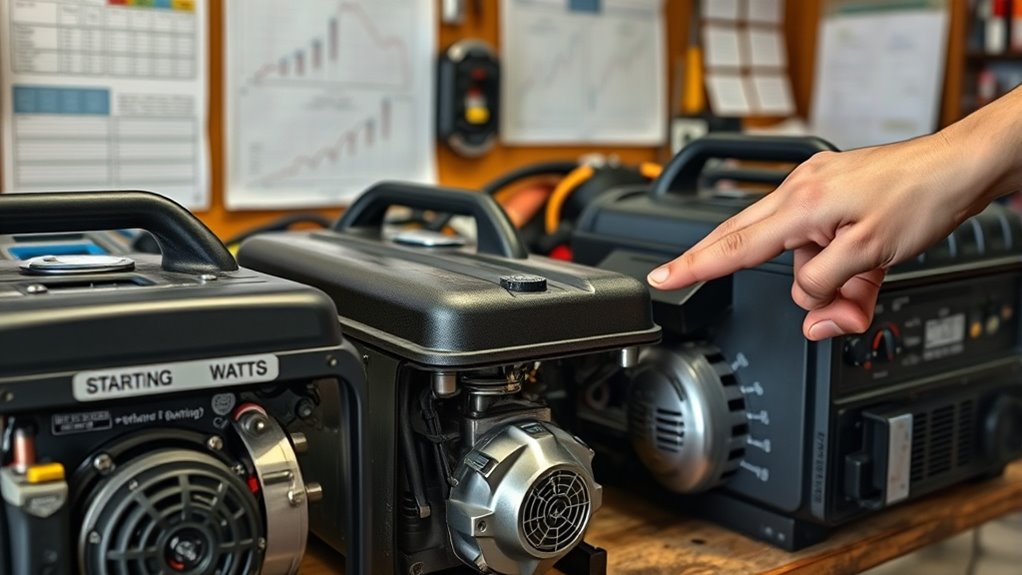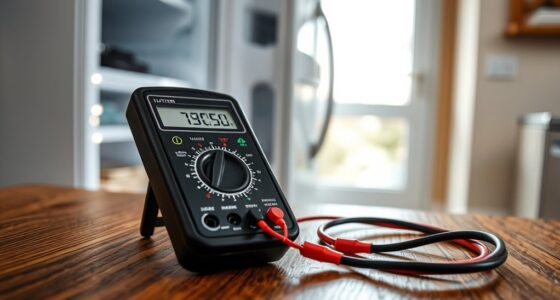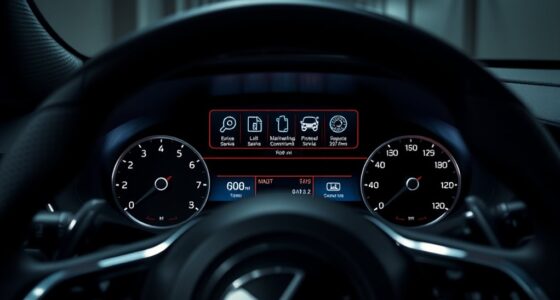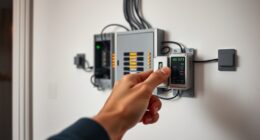Many people confuse starting watts with running watts, leading to improper generator or inverter sizes. They often underestimate the surge needed for motors and appliances, risking stalls or damage. Labels can be misleading, and ignoring surge capacity when multiple devices run together can cause overloads. Assuming all devices have similar startup demands or relying solely on continuous wattage causes problems. Keep in mind, understanding each device’s true power needs can prevent many common mistakes—if you continue, you’ll uncover how to get it right.
Key Takeaways
- Many people assume starting watts are simply 2-3 times the running watts, but the actual ratio varies by device.
- Consumers often overlook surge power requirements for motors, risking equipment stalls or damage during startup.
- People frequently rely solely on appliance labels that list only running or starting watts, ignoring the importance of surge capacity.
- There’s a common misconception that a generator’s continuous wattage rating suffices, ignoring the higher surge needs during startup.
- Many underestimate how multiple devices’ surge demands can combine, leading to overloads if not properly calculated.
Confusing Surge Power With Continuous Power
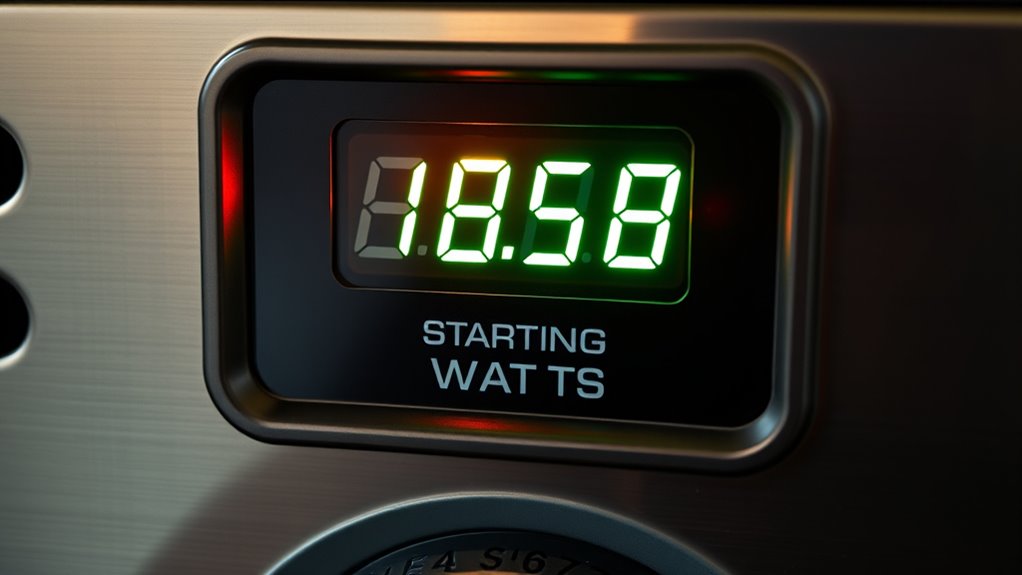
Many people mistakenly think that surge power and continuous power are interchangeable, but they serve different purposes. Surge power is a brief, high-intensity burst needed to start appliances with motors or compressors, lasting only milliseconds to a few hundred milliseconds. Understanding power ratings is crucial because it helps differentiate between the immediate surge needed for startup and the steady wattage required for continuous operation. Continuous power, on the other hand, is the steady wattage your inverter or generator can supply safely for extended periods. If you rely solely on continuous power ratings, you might underestimate the surge needs of appliances like refrigerators or pumps, which require a much higher initial wattage to overcome mechanical resistance. Surge ratings are usually 2 to 3 times higher than continuous ratings but apply only for short durations. Proper sizing of inverters is essential to ensure that both surge and continuous loads are managed effectively without risking damage or shutdown.
Underestimating the Importance of Starting Watts for Appliances With Motors
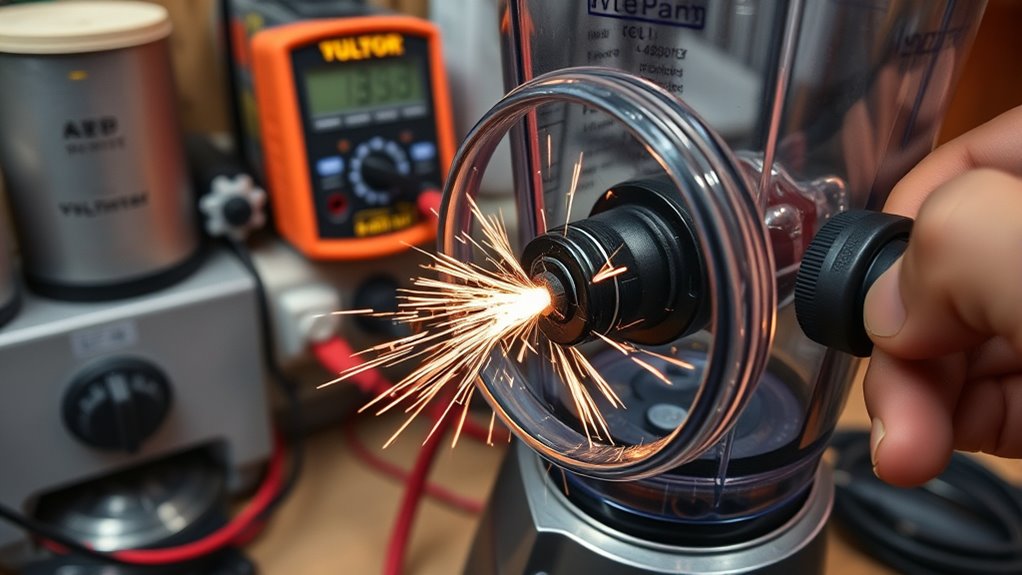
If you underestimate the starting watt needs of motor appliances, they might not start properly or could overload your power source. This can cause frequent stalls, circuit trips, or damage to your equipment. Properly estimating starting watts helps make certain of reliable operation and protects your appliances and generator. Accurately accounting for surge wattage ensures your setup can handle the initial power spike safely. Additionally, understanding the difference between starting and running watts is essential for selecting the right power equipment.
Motor Startup Power Surge
Have you ever overlooked how much power an appliance with a motor needs to start up? That initial surge, called the motor startup power surge, is vital because it overcomes mechanical inertia and gets the motor running smoothly. This surge often demands two to three times more power than the appliance’s normal operating wattage. Although it lasts only a few seconds, it’s intense enough to cause overloads if your power source isn’t rated for it. Many appliances like refrigerators, air conditioners, and pumps need this extra burst to start properly. Failing to account for startup wattage can prevent appliances from turning on or damage your generator. Properly estimating starting watts ensures you choose a power source that can handle these brief, high-energy demands without risking failure or damage. Understanding the difference between starting and running watts is key to selecting the right capacity for your power needs.
Underpowered Generator Risks
Underestimating the importance of starting watts can lead to serious problems when using an underpowered generator. Many appliances with motors require 3-7 times their running watts to start properly. If your generator can’t supply this surge, motors may stall or fail to start altogether, causing repeated stress and wear on the appliance. Voltage drops during startup can also damage internal components or trip circuit breakers, risking premature failure. Over time, these issues cause overheating, degrade motor health, and increase maintenance costs. Running a generator below its capacity leads to inefficiencies like poor combustion and carbon buildup, further harming its lifespan. Additionally, not accounting for surge capacity can compromise your entire backup setup. Ignoring starting watt needs can result in frequent breakdowns, reducing reliability and risking safety during power outages. Properly matching the generator’s starting watt capacity to the appliances’ needs is essential for ensuring smooth operation and avoiding costly repairs.
Accurate Wattage Estimation
Accurate wattage estimation is essential for ensuring your appliances start reliably without risking damage or system overloads. Many overlook the fact that appliances with motors need a surge of power—often 2 to 3 times their running watts—to overcome initial inertia. Failure to account for this surge can cause startup failures or damage. To visualize, consider the table below:
| Appliance Type | Starting Watts | Running Watts |
|---|---|---|
| Refrigerator | 600–900W | 300–400W |
| Air Conditioner | 2000–3000W | 1000–1500W |
| Pump/Compressor | 1500–2500W | 700–1200W |
Overlooking the Need for Surge Capacity in Generator Sizing
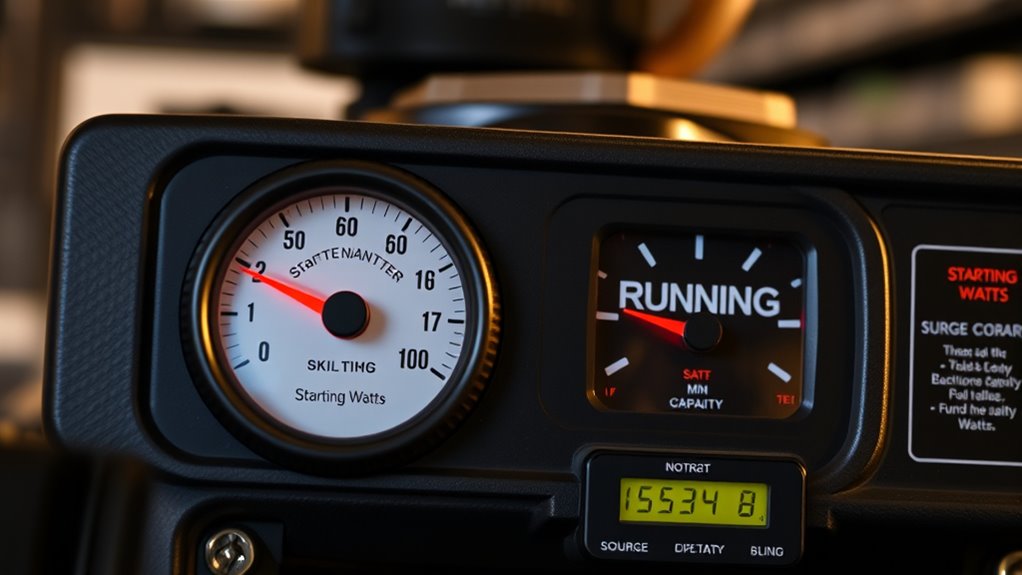
Overlooking the need for surge capacity can lead to serious problems when selecting a generator. Many underestimate how much extra power appliances with motors require during startup, risking overload or failure. Surge watts are often notably higher than running watts, so ignoring this difference can result in a generator that can’t handle the initial spike. If your generator doesn’t supply enough surge capacity, motors like those in air conditioners or refrigerators won’t start, causing operational disruptions or damage. To prevent this, you should identify the highest surge wattage of your appliances and add it to the total running watts. Adding a safety margin of 10-25% ensures reliable startup and prolongs your generator’s lifespan, especially for critical or commercial applications.
Assuming Running Watts Are Sufficient for All Startup Demands
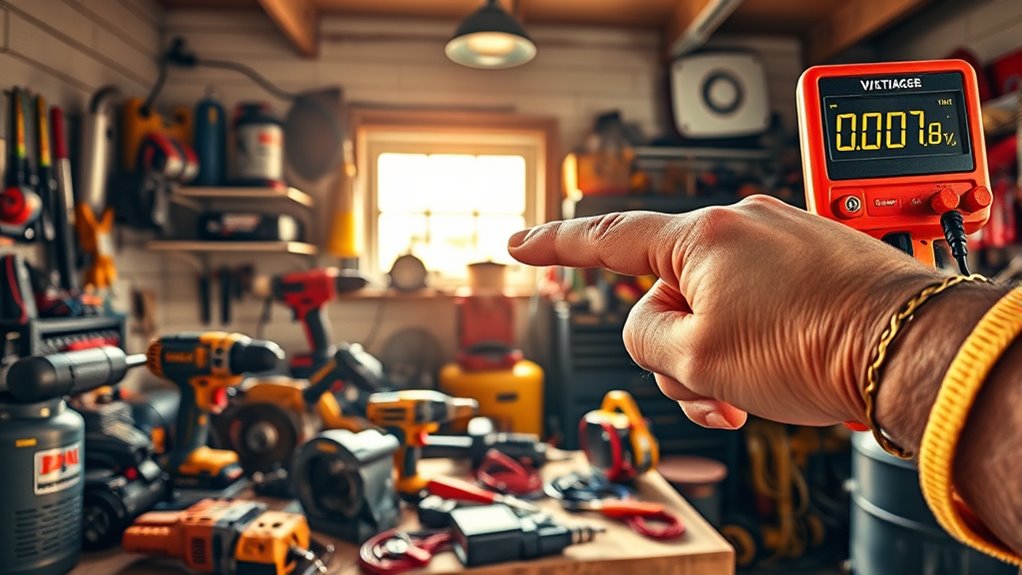
Many people assume that the running watts listed for appliances are enough to handle their startup power needs, but this is a common misconception. Running watts reflect continuous power during normal operation, not the surge needed to start motor-driven devices. For example, refrigerators and pumps often require 2-3 times their running watts at startup. Ignoring this can overload your generator or cause appliances to fail to start. To avoid issues, you should add the highest starting watt requirement to your total running watts, not just rely on running watts alone. Here’s a quick comparison:
| Appliance Type | Typical Running Watts | Starting Watts Needed |
|---|---|---|
| Refrigerator | 700W | 2100W |
| Light | 100W | 100W |
| Pump (1/2 HP) | 900W | 2300W |
This approach guarantees your generator can handle both continuous and surge demands. Remember that some appliances, like refrigerators, have a surge wattage that can be significantly higher than their running watts, so always check the manufacturer’s specifications and consider the surge capacity of your power source. Additionally, understanding the power requirements ensures safe and efficient operation of your appliances during startup.
Misreading Product Labels and Manufacturer Specifications
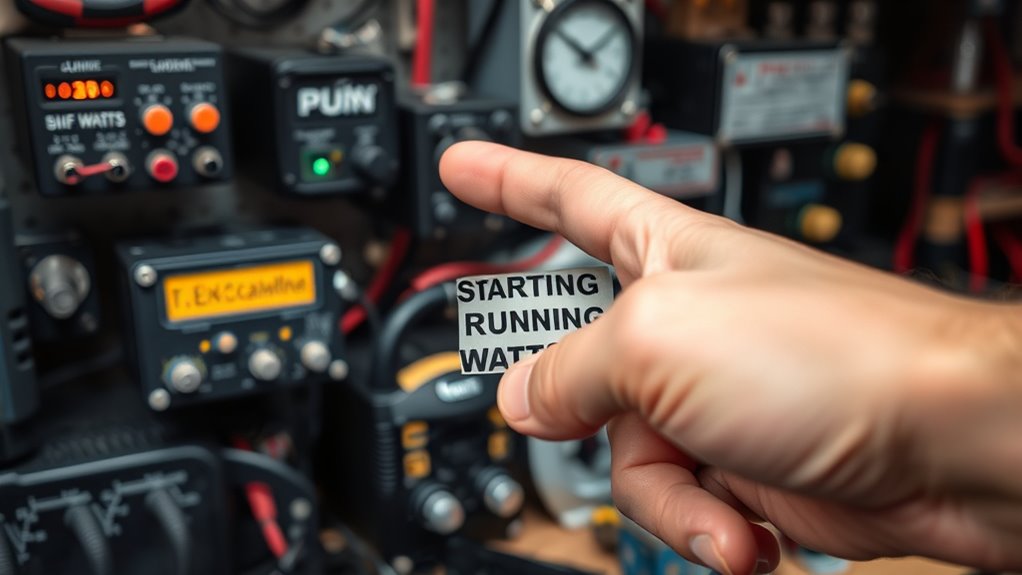
Product labels often only list amps and volts, which can lead you to miscalculate the actual wattage your appliances require. You need to multiply volts by amps to find watts, but many overlook this step or misapply it. Some labels only show running watts or specify only starting watts, causing confusion about peak power needs. Manufacturers may omit essential details like surge wattage or how long the maximum power lasts, making it harder to size your generator correctly. Labels can also use inconsistent terminology—surge watts, peak watts, rated watts—without clear definitions. Relying solely on manufacturer specs without considering these nuances risks underestimating your generator’s capacity. Always verify wattage calculations from amps and volts and understand whether the listed values represent continuous or short-term power demands. Failure to do so can lead to selecting an underpowered generator that cannot handle appliance startup surges, especially when considering generator capacity ratings that may not reflect real-world usage.
Ignoring the Power Demands of Multiple Devices Operating Simultaneously
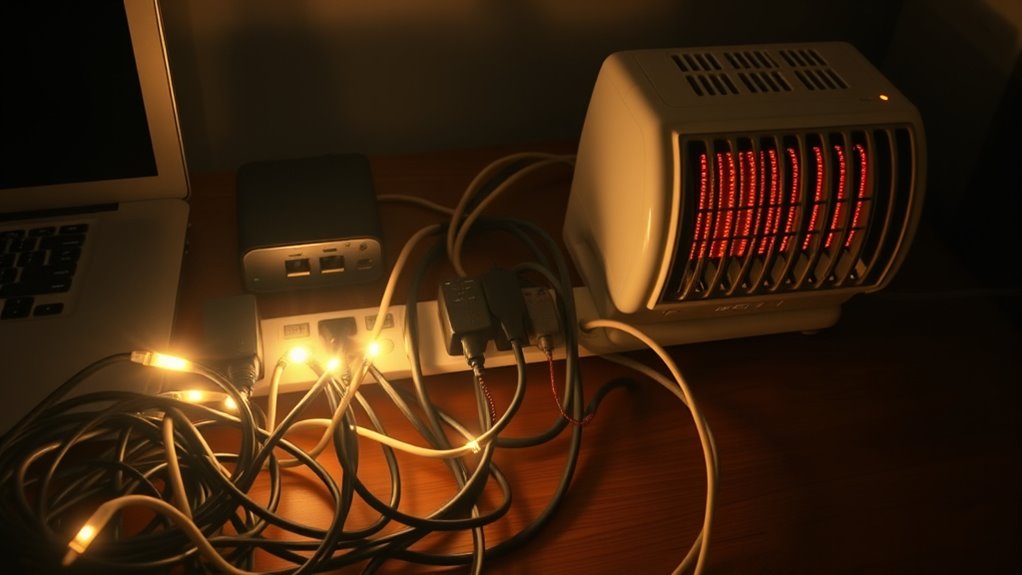
When you run multiple devices at the same time, it’s easy to underestimate how much power they need collectively. Overestimating your power source’s capacity or ignoring surge demands can lead to unexpected shutdowns or damage. You must account for both the steady and peak power requirements of each device to keep everything running smoothly. Advanced power management features in modern power stations help optimize energy distribution and prevent overloads during such simultaneous use. Additionally, understanding your budgeting can help allocate resources effectively for reliable energy solutions.
Overestimating Power Capacity
Overestimating your power capacity often leads to serious issues when multiple devices run at the same time. Many users wrongly assume that adding up device wattages gives an accurate total, but this ignores how power demands spike during simultaneous operation. Basic inverters often hit low wattage limits, and without intelligent distribution, overloads or shutdowns happen unexpectedly. When to Use Device Nesting This can be especially problematic in complex setups where multiple devices are interconnected, making proper load management essential. Additionally, understanding power demand spikes is crucial to prevent system failures.
- Power consumption multiplies with multiple devices, often exceeding capacity.
- Common units lack smart systems to balance loads, risking damage.
- Users underestimate total wattage by ignoring simultaneous demand spikes.
To avoid problems, consider real-time monitoring tools and smart distribution systems. These help manage loads more accurately, preventing overloads and ensuring your setup runs smoothly without costly surprises.
Underestimating Surge Requirements
Operating multiple devices at the same time can cause power surges that far exceed what your surge protectors are rated to handle individually. When several gadgets run simultaneously, their combined surge currents can overload surge protectors if they don’t have enough capacity. Many devices generate brief but intense surges during startup, which add up when multiple units turn on together. If your surge protector’s joule rating isn’t high enough, it’ll degrade faster or fail, leaving your electronics vulnerable. Lightning strikes or grid switching also create large, widespread surges affecting all connected devices. Relying on a single surge protector or underestimating the total surge capacity can lead to damage, reduced protection over time, and increased risk of equipment failure. Always match your surge protection to the total power demands of all connected devices. Additionally, understanding surge capacity helps in selecting the appropriate safeguard to prevent overloads and ensure long-term protection.
Believing All Devices Have Similar Starting-to-Running Watt Ratios
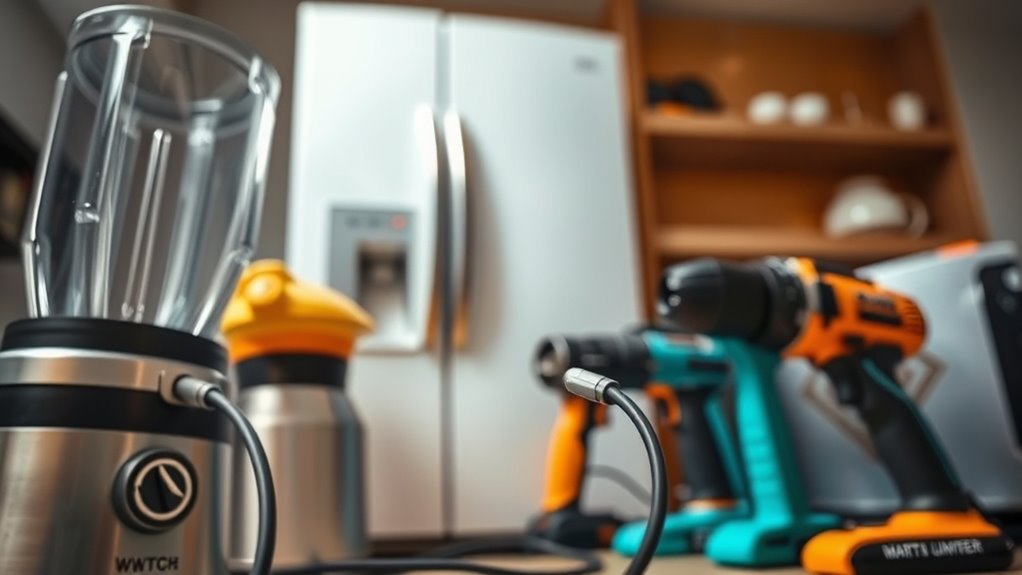
Many people assume that all devices have similar starting-to-running watt ratios, but this isn’t the case. Different appliances have varying surge demands based on their motor or compressor size. For example, refrigerators often need 2 to 3 times more starting watts due to compressor surges, while small electronics may have starting watts close to their running watts. Pumps and compressors can spike over double their operating wattage, sometimes even more. Appliances without motors, like resistive heaters or incandescent lights, typically show little to no surge. Modern heat pumps, which incorporate advanced noise reduction technology, are also designed to operate more efficiently and quietly during startup.
Frequently Asked Questions
How Do I Determine the True Starting Wattage of My Appliances?
To find your appliance’s true starting wattage, use a clamp meter with inrush current detection during startup. Alternatively, check the data plate for Locked Rotor Amps (LRA) and multiply that by your voltage. You can also measure amps with a watt meter at startup. Just remember, appliances with motors or compressors draw more power initially, so measuring directly gives the most accurate results.
Can a Generator Handle Multiple Appliances With High Starting Watts Simultaneously?
Yes, your generator can handle multiple high-startup appliances, but only if you’re smart about it. Imagine trying to fit a herd of elephants through a tiny door—overload happens fast! To avoid this, stagger the startup times, guarantee your generator’s surge capacity exceeds the combined starting watts, and don’t push it beyond 80% of its rated capacity. With careful planning, you can run multiple appliances without tripping or damage.
Why Is It Risky to Ignore the Surge Power Needs When Choosing a Generator?
Ignoring surge power needs when choosing a generator is risky because it can cause overloads during appliance startup, leading to potential damage or failure. You might experience voltage drops, frequent tripping, or even shortened equipment lifespan. Without accounting for surge watts, your generator could run near maximum capacity constantly, reducing efficiency and risking safety. Always include surge requirements in your calculations to guarantee reliable power and protect your appliances.
Do All Appliances Require the Same Ratio of Starting to Running Watts?
No, not all appliances need the same ratio of starting to running watts. Motor-driven devices often require 1 to 3 times their running watts to start, while simple electronics may need little to no surge. You should evaluate each appliance’s specific starting and running watt requirements rather than assuming a uniform ratio. This way, you’ll ensure your generator can handle the surge demands without risking overload or damage.
How Can I Accurately Read Product Labels for Wattage Specifications?
You can accurately read product labels by closely examining the wattage specifications. Use a magnifying glass or your phone to read small print, and cross-reference the values with the manufacturer’s manual or datasheets. Check if the wattage listed is for starting or running power, especially for motors. Look for voltage ratings and efficiency labels too, ensuring they match your power source for safe, proper use.
Conclusion
So, next time you’re choosing a generator, remember these common mistakes. It’s funny how often people overlook surge capacity or assume all devices are the same, only to find out too late. Sometimes, understanding starting watts feels like a coincidence—luck isn’t enough when your appliances demand more. Stay informed, check specs carefully, and you’ll find that what seems like a small detail can make all the difference when power needs align perfectly.

